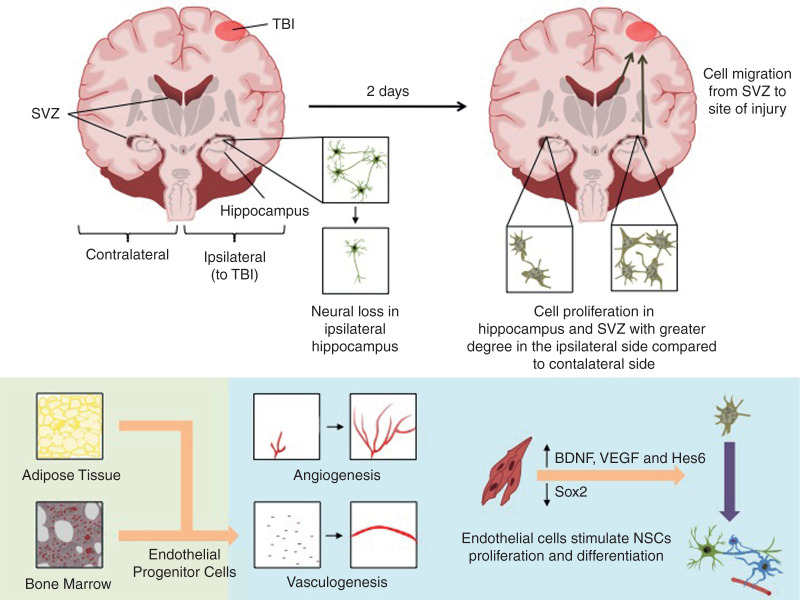Fig 1.
Neurogenesis and Angiogenesis After Traumatic Brain Injury. Neurogenesis occurs throughout adult human life in two different zones of the brain: the subgranular zone of the hippocampus dentate gyrus, and the subventricular zone (SVZ) of the lateral ventricles - olfactory bulb pathway. The hippocampus and the SVZ generate neural stem cells (NSCs), which are self-renewing and multipotent. NSCs can generate neural progenitor cells (NPCs), which do not maintain the NSCs pool but rather generate neuronal and glial cells. After the initial neuronal loss in the hippocampus after traumatic brain injury (TBI): (a) Neurogenesis increase in the SVZ and in the hippocampus as early as two days, essentially in the ipsilateral side of the injured brain but also in the contralateral side to a lesser extent. Neurogenesis remains usually high for two weeks in the SVZ and one month in the hippocampus, and sometimes last up to one year. NSCs can therefore migrate directly from the SVZ to the site of injury and differentiate into neuronal and glial cells. New neurones can extend axonal projections to the cornu ammonis (CA)-3 region of the hippocampus two weeks after TBI, leading to cognitive improvement. (b) Angiogenesis from pre-existing vessels and vasculogenesis from bone-marrow and adipose-tissue derived endothelial cells are also stimulated after TBI. Increased angiogenesis has been shown three days after injury, with proliferation of endothelial cells by twelve hours. Endothelial cells also stimulate the proliferation and differentiation of NSCs and migration of neuroblasts, in part through the production of soluble growth factors such as the brain derived neurotrophic factor (BDNF) and vascular endothelial growth factor (VEGF). Endothelial cells also promote neuronal differentiation by up- and down- regulating Hes6 and Sox2 expression, respectively. Although effective after minor brain injury, these mechanisms may be insufficient after severe TBI. BDNF, brain derived neurotrophic factor; CA, cornu ammonis; Hes6 and Sox2, transcription factors; NPC, neural progenitor cells; NSC, neural stem cells; SVZ, subventricular zone; TBI, traumatic brain injury; VEGF, vascular endothelial growth factor.

